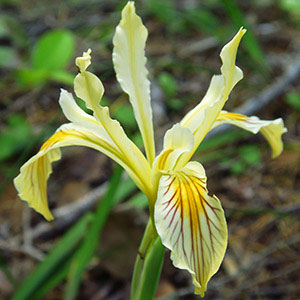Iris purdyi
Iris bracteata
Purdy's iris, redwood iris
Siskiyou iris
much branched, forming dense clumps, dark red-brown, very slender, 0.3–0.6 cm diam., covered with remains of old leaves;
roots fibrous.
sheathed with old leaf bases, slender, 0.6–0.9 cm diam.;
roots few, fibrous.
simple, solid, 1.5–2.5 dm.
simple, solid, 1.5–3 dm.
basal few, laxly spreading, longer than stem, blade bright dark green adaxially, flushed pink basally, veins subprominent, linear, 2.8–4.8 dm × 0.5–0.8 cm, rather glaucous abaxially, margins thickened, apex acute;
cauline imbricated, sheathing, free only at tips, bracteiform, blade green edged with pink, strongly striate, inflated, apex acuminate.
basal with abaxial surface of blades deep glossy green on one side of fan, light yellow-green on other side, pink or red-tinged basally, strongly ribbed, 4–6 dm × 0.8–1 cm, rigid, margins not thickened;
cauline 3–6, imbricated, closely sheathing stem ca. 2/3 length, spreading distally, bractlike, blade inflated, often shorter than basal leaves.
1–2-flowered;
spathes green with prominent red margins, inflated, broadly lanceolate-ovate, 5.6–7 cm × 8–13 mm, unequal, outer shorter than inner, herbaceous, apex acuminate.
simple, units 1–2-flowered;
spathes closed tightly around pedicel and ovary, lanceolate, 5.2–9 cm × 6–8 mm, subequal, herbaceous, margins scarious, apex acuminate.
perianth pale creamy yellow flushed with pale lavender, with conspicuous brownish purple lines;
floral tube linear, 3–5 cm, somewhat dilated apically;
sepals widely spreading, veined and dotted with deeper purple on claw and limb, oblanceolate, 5.5–8.4 × 1.6–2.7 cm;
petals spreading, lanceolate, 5–7 × 1–2 cm, margins sinuate;
ovary trigonal in cross section with groove along each angle, narrow, 1–1.5 cm;
style 2–3 cm, crests narrowly semiovate or nearly linear, laciniate, 1–2 cm;
stigmas rounded-truncate to 2-lobed, never triangular, margins minutely denticulate;
pedicel 1–2 cm.
perianth cream to buff-yellow;
floral tube 0.8–0.9 cm;
sepals with deeper yellow signal, veined with purple or brown, obovate-lanceolate, 6.5 × 2.5 cm, base gradually attenuate into wide claw;
petals narrowly oblanceolate, 7–9 × 0.8–2 cm, base gradually attenuate;
ovary nearly circular in cross section, 1.5–2.5 cm, base gradually attenuate into pedicel, apex abruptly acuminate into floral tube;
style 2.2–3 cm, crests spreading, yellow, not veined, 1.2 × 0.9–1.7 cm, margins toothed;
stigmas triangular or tongue-shaped, margins entire;
pedicel 3–6.2 cm.
oblong-ovoid, trigonal, somewhat beaked, 2–3 cm.
nearly circular in cross section, tapering abruptly at each end, 2–2.5 × 1–1.5 cm.
light brown, D-shaped, oblong-ovoid, thick, finely wrinkled.
dark brown, irregular in shape, wrinkled.
= 40.
= 40.
Iris purdyi
Iris bracteata
Iris purdyi hybridizes with I. bracteata, I. chrysophylla, I. douglasiana, I. innominata, I. macrosiphon, I. tenax, and I. tenuissima.
(Discussion copyrighted by Flora of North America; reprinted with permission.)
Iris bracteata is limited to one county each in northern California and southern Oregon. It hybridizes with I. chrysophylla, I. douglasiana, I. innominata, I. munzii, I. purdyi, and I. tenax.
(Discussion copyrighted by Flora of North America; reprinted with permission.)


